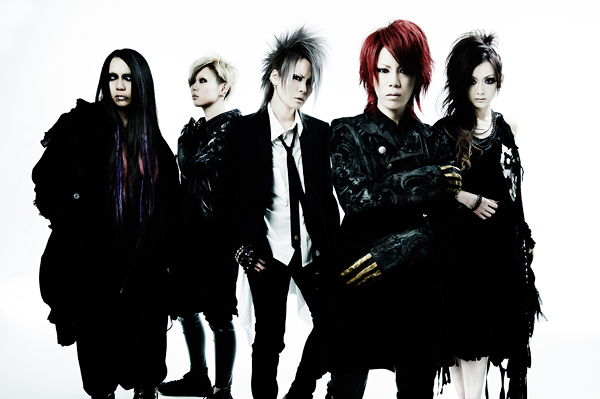exist†trace
Interview by David Cirone
June 12, 2011

PART 1
exist†trace members Jyou, miko, Omi, Naoto, and Mally gave this interview on April 25, 2011, just 2 days after their debut American live show at Sakura-Con 2011.
Over 3000 fans attended your first one-man show here in America. How did it feel?
Jyou: I was so shocked. I’m still shocked.
Mally: I really can’t believe it.
Jyou: It’s not just that there were a lot of people, it’s that we were so afraid that no one knew us here.
During your Sakura-Con live show, you performed the title track from your upcoming EP “TRUE”. Fans are familiar with your other songs from music videos and your previous releases, but this was a song that no one in the audience had ever heard before. Was it a risky choice to include it?
Jyou: Our major-label debut CD “TRUE” is coming out soon, and we wanted to give our fans a glimpse of the future of exist†trace, not just the past. The other day we just finished shooting the PV for this song in Japan.
Speaking of PVs, your music videos have been very successful in building your international audience. How important are music videos to the band?
miko: With videos we’re able to express ourselves through a visual format. Our songs all start just as audible experiences, so the videos bring a new dimension. For our overseas fans who can’t see us regularly in Japan, it’s the best way for them to get to know us.
You’ve talked about wanting to do more shows in America. Why is America an important audience for you?
Jyou: From the beginning, it was always our dream to go to America. Miko especially really loves America!
Mally: Because we’d already been to Europe twice, one of our dreams had been realized. So it’s natural for us think about the next dream. And here we are.
Naoto: Simply stated, 10 songs wasn’t enough. As soon as the last song finished, we all knew we wanted to do more.
Why do you choose to become a visual kei band?
Jyou: When we started, there were no female visual kei groups. We didn’t think there was any reason there shouldn’t be one.
Naoto: Growing up, I was really affected by visual kei style. This style allows us to express ourselves. It didn’t seem wrong that there could be a group of all girls, so why shouldn’t we be the ones?
Does visual kei allow you to create a new persona? Does this give you more freedom?
Mally: I agree, I can express myself more freely. I have a lot of complex feelings inside, but I can express myself this way. I think my true personality can come through, and it makes me feel really strong.
Omi: I can become the person I want to be. Within this style of performing, I’m doing what I want to do, and it’s got nothing to do with being male or female. It’s really fun. I love doing it.
Two of your music videos feature the image of a dragging chain: your earliest video, “Judea,” and your latest video for “Resonance.” Is there a connection?
miko: The image of the chain in “Judea” was connected to the story of internment camps in Nazi Germany, and the main character has been captured. So maybe it’s not tied so strongly to the lyrics as the chain from “Resonance.” In “Resonance,” the broken chain represents a break from restraints, it represents freedom.
Let’s talk about the style of Jyou’s microphone. In the videos for “Vanguard” and “Resonance,” you’ve been holding this large stylized microphone. What can you tell us about it?
Jyou: In our live shows, we use a normal mic, not the vintage mic. But we’ve been using it the videos because it’s cooler. It has a better effect. I’m thinking maybe we should use it in the live show, too.
Mally: For “Vanguard” there was something special about it, I think. It was modified a little bit.
Jyou: (to Mally) You have a great memory! (laughs) Of course we’re using it again for the “TRUE” video. In a PV, if it’s just something normal, it doesn’t leave a lasting image. I want to leave a strong impression, and recently I’ve realized how cool that mic is. I really like the feeling of wrapping my whole hand around it — it’s powerful!
What’s the meaning of the title TWIN GATE?
Jyou: A twin gate… it’s about living and dying. There’s a story that every person talks to God before they’re born. You ask God your fate, and the things you’re told at that point are not all good things, and you might learn that your fate is to die early, or die late. Maybe you’ll have a hard life. And you have to make a decision: to be born or not to be born. You have to choose to pass through one of these gates. I heard that story a long time ago, and that’s how we found the title of this album.
The first song is “DECIDE,” and, just like us, our listeners have to make a decision. To move forward when life is hard, you have to have courage, and “DECIDE” is designed to give them the power to make that decision. In TWIN GATE we have a combination of old and new songs, so it’s a decision from exist†trace. We decided that we can keep the old and also make something new.
How does this connect to the cover image, where your backs are turned away from the gate?
Jyou: With that image of our backs turned, we wanted to present the question visually. We’ve already passed through one of the gates, but which decision did we make?
